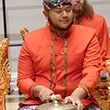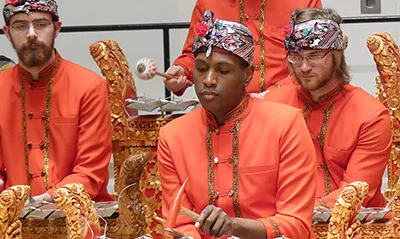King of Cranes - Gamelan Performance

Gamelan, the traditional music of Bali and Java, never came easily to Daniel Underhill Professor of Music Tom Whitman ‘82.
Whitman, who founded the College ensemble Gamelan Semara Santi and will continue to be involved after his forthcoming retirement from the music faculty, first learned to play when he was 26 years old and still records and transcribes his lessons in order to teach the music. By contrast, the student performers in the ensemble have taken to gamelan with comparative ease.
“My students who are much younger than I am and are also much more adept at learning things through an oral tradition than I am or ever was,” he says. “By the time I went to Indonesia, I was already six or seven years older than they are now.”
Looking to branch out from the Western classical canon, Whitman began studying Balinese music in Indonesia as a Luce Scholar at the recommendation of now-colleague Jane Lang Professor of Music Gerald Levinson. Despite the considerable difficulty of learning a new language and a new musical tradition on the fly, Whitman was profoundly impacted by the experience and its influence would later lead him to establish the ensemble in 1997.
Gamelan, which predominantly utilizes gongs, drums, metal xylophones, strings, and flutes, often tunes on a five-tone scale called pelog based on the sounds “ding,” “dong,” “deng,” “dung,” and “dang.” Music follows a cyclical pattern in which ideas are repeated without interruption and specific instruments, usually the gongs, are struck to denote fixed time intervals.
For example, during every 16-beat cycle, one gong marks the 16th beat, while a smaller one indicates the halfway point on beat eight. An even smaller gong might be struck on beats four and 12, dividing the pattern into quarters. Other instruments provide variation during each cycle and dancers coordinate their movements to the music in a continuously shifting interplay.
This circular structure and a lack of conventional harmony help set gamelan apart from the tropes of Western music that are familiar to most audiences. Whitman also emphasizes the unique social aspect of the ensemble and unity that performances foster between its members.

The group has grown to encompass those outside of the student body and even faculty and staff. Photo by Shelby Dolch '21
“You often have these moments when you’re lost in the texture and you’re playing something, but you can’t really be sure whether it’s you who’s playing that note or someone else,” he says. “There’s a social togetherness there that you don’t find in something like a Western orchestra.”
Between this cohesion and the observation of customs such as removing one’s shoes before playing and teaching through oral tradition, Whitman has aimed to emulate the cultural experience of gamelan one might have in Indonesia. To this end, Gamelan Semara Santi planned to hold an outdoor concert on April 15 at Hawthorne Park in South Philadelphia and engage the Indonesian community that had settled in the area since the group’s inception.
“Swarthmore’s full ensemble has never performed for an audience of Indonesian-Americans, so we thought this would be an appropriate capstone for our 20th anniversary season,” Whitman says.
Unfortunately, the event was canceled due to inclement weather but one week prior, the group collaborated with the recently established Chinese Music Ensemble for a performance in Lang Concert Hall.
Over the past 20 years, Gamelan Semara Santi has been sustained by its strong sense of community. The group has grown to encompass those outside of the student body and even faculty and staff. Its members span several generations and varying levels of experience, making it easily accessible for the curious beginner.
“Through the weekly rehearsals and sectionals, I have been able to spend time with an incredible group of musicians, nearly all of whom came to Gamelan without previous experience,” says Jacob Demree ‘19, an honors medical anthropology special major from Mount Laurel, N.J.
“Coming to rehearsal is a highlight of my week and has been since freshman year, and I look forward to continuing to work with the group and Professor Whitman through the rest of my time at Swarthmore.”



